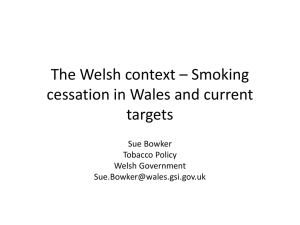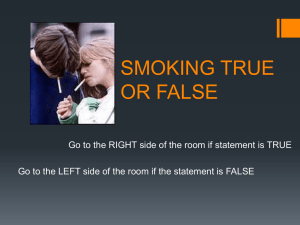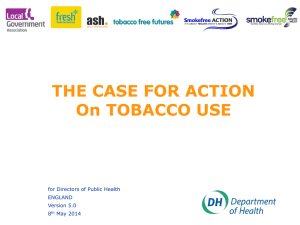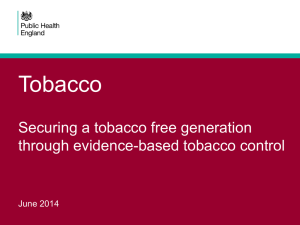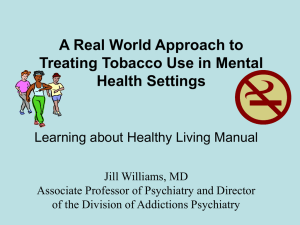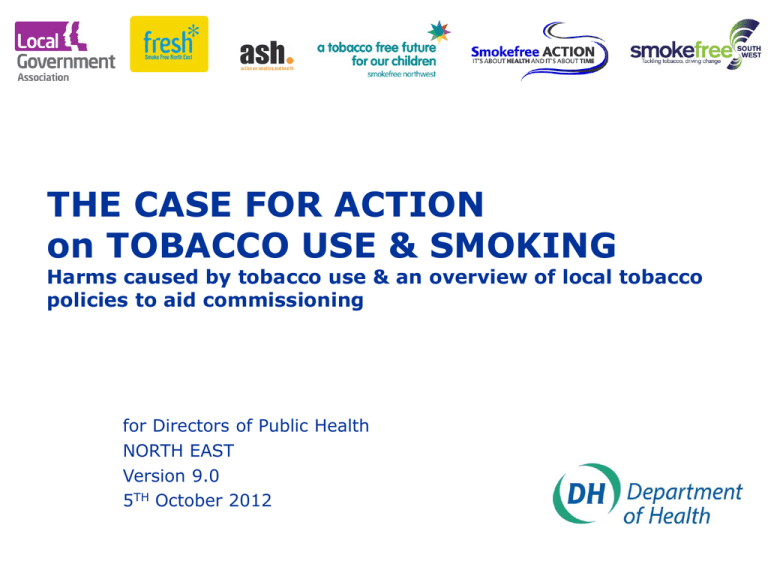
THE CASE FOR ACTION
on TOBACCO USE & SMOKING
Harms caused by tobacco use & an overview of local tobacco
policies to aid commissioning
for Directors of Public Health
NORTH EAST
Version 9.0
5TH October 2012
1. Scale of the challenge
Public health: tobacco use
Each year smoking causes the greatest
number of preventable deaths
Alcohol:
6,541
Smoking:
81,400
Obesity:
34,100
Traffic:
2,502
Suicide:
5,377
References:
1. ASH Factsheet, Smoking Statistics: illness & death, June 2011 (http://ash.org.uk/files/documents/ASH_107.pdf) NB area represents value
HIV:
529
Drug misuse:
1,738
3
Public health: tobacco use
Decline in national smoking rates has
stalled
35
30
23%
% 25
22%
NB Illustration: please click on the
chart to enter your regional and
local data: in this illustration the NW
and Liverpool are used for
comparison
20
15
21%
10
1998
2000
2001
2002
Your region
2003
2004
2005
Your borough
2006
2007
2008
2009
National
References:
1. Integrated Household Survey 2009 (mid-point estimate for locality given small sample size and large confidence interval)
4
Public health: tobacco use
Children’s rates of smoking
14
12
10
8
6%
6
5%
4
4%
2
0
1982
1986
1990
1994
1998
Boys
2002
Girls
2004
2006
2008
2009
2010
Total
References:
1. Smoking, drinking and drug use among young people in England in 2009. National Centre for Social Research, 2010: NHS Information Centre for Health and
Social Care.
5
Public health: tobacco use
Smoking-related diseases
Smoking attributable deaths from major diseases (2009)
1277
Cancers
20616
Respiratory
37539
Cardiovascular
Digestive
Total deaths: 87,000
22017
References:
1. NHS Information Centre (2009), Statistics on smoking: England 2009 available at
www.ic.nhs.uk/webfiles/publications/smoking09/statistics_on_smoking_england_2009.pdf
6
Estimated cost of smoking in Blackpool (£ millions)
18
References:
1. Cough Up, Policy Exchange, 2010
£16.6m
£10.9m
£10.1m
£11.7m
£13.74
Billion
Output lost from
early death
Smoking breaks
0
6.
NHS care
2
Sick days
4
5.
Total cost of
smoking to
England’s
economy &
health service is
£2.8m
4.
6
Passive smoking*
8
£2.1m
3.
10
Domestic fires
2.
12
Excel spreadsheet.
Click on the “Reckoner” tab at the
bottom of the chart.
Scroll to the top of the spreadsheet to
select your region and Council. The
spreadsheet should automatically
calculate the costs for your area.
Print page 2 of the spreadsheet for a
handout to use with your presentation.
Click on the “Chart 1” tab at the
bottom of the spreadsheet and simply
click outside the chart area. To return
to the slide presentation.
You should now have a chart of your
local data displayed. The chart may
need to be repositioned on the slide.
£1.4m
1.
14
*Passive smoking: lost
Using
the slide
on local
productivity
from early
death costs of
(not including NHS
costs
and
smoking:
absenteeism)
Double
click on the chart to open the
Smoking litter
16
Millions (£)
Public health: tobacco use
Smoking costs the local economy millions
every year
7
Public health: tobacco use
Cost of smoking to smokers
1.
2.
3.
4.
5.
6.
Using the slide on local costs of
smoking:
Double click on the chart to open the
Excel spreadsheet.
Click on the “Reckoner” tab at the
bottom of the chart.
Estimated cost to smokers and society in Blackpool
Scroll to the top of the spreadsheet to
(£ millions)
select
your region
Smokers'
spendingand
on Council. The
spreadsheet
should automatically
tobacco
calculate the costs for your area.
Print page 2 of the spreadsheet for a
Totalto
costs
society
£54.3m
handout
usetowith
your presentation.
Click on the “Chart 1” tab at the
bottom of the spreadsheet
and simply
0
10
20
30
40
50
Millions (£)
click outside the chart area. To return
to the slide presentation.
You should now have a chart of your
local data displayed. The chart may
need to be repositioned on the slide.
£63.1m
60
70
Over three quarters of the cost of tobacco is tax &
national tobacco tax revenue is c£10bn – this is £4bn
less than the total national costs of smoking.
References:
1. Cough Up, Policy Exchange, 2010
2. HMRC
8
Public health: tobacco use
Health cost of smoking in your area
NB please use your local data
from
http://www.lho.org.uk/LHO_TOPIC
S/ANALYTIC_TOOLS/TOBACCOC
ONTROLPROFILES/profile.aspx?
Copy from the ‘pdf’ as this
provides the clearest image.
Because of the detail on this
slide may be more effective if
accompanied by a “handout”.
9
30
28
Projected trend for smoking rates if
investment in tobacco control is
ceased
26
Since first undertaking this
analysis in 2009 our
predictions have turned out to
be too positive; showing that
more concerted and
reinvigorated action is even
more of a priority
24
22
20
18
Actual
Forecast trend
16
20
01
20
02
20
03
20
04
20
05
20
06
20
07
20
08
20
09
20
10
20
11
20
12
20
13
20
14
20
15
Public health: tobacco use
If we do nothing – smoking rates will rise
References:
1. UCL, ‘Pipe Model’, smokinginengland.co.uk
10
Local smoking rates differ greatly
Public health: tobacco use
22
22
23
All across England there is
more room for progress:
In California smoking rates
have fallen to a historic low
of 11.9%
19
19
22
18
22
19
References:
1. Smoking & drinking among adults, 2009. General Lifestyle Survey, ONS, 2011. 2. http://www.cdph.ca.gov/Pages/NR11-031.aspx
11
2. Smoking attitudes &
behaviours
Public health: tobacco use
The different ‘stages of smoking’
Reduce the
appeal and
supply of
tobacco
Protect
families &
communities
Take-up
smoking
Relapse
Support quit
attempts
Quitting
attempt
Encourage
more quit
attempts each
year
Decision
to quit
13
Public health: tobacco use
Children not adults start smoking
• Children not adults start smoking: 90% of
smokers started before the age of 191
• 99% of 16 year old regular smokers live
in a household with at least one other
smoker2
• Children are three times as likely to start
smoking if their parents smoke1
References:
1. Smoking Attitudes & Behaviours (200(), ONS 2011
2. Dr Susan Woods, The Liverpool Longitudinal Study on Smoking : Experiences, beliefs and behaviour of adolescents in Secondary School (2002-2006),
Liverpool John Moores University, August 2008
14
Public health: tobacco use
Smoking, pregnancy & inequalities
Pregnant women in
the lowest socioeconomic group
smoke at almost
three times the rate
of those in the
highest.
50
Socio-economic group: % who smoked before or during
pregnancy
40
40
26
30
14
20
10
0
Managerial & professional
60
Routine & manual
Age: % who smoked before or during pregnancy
70
Smoking rates for
teenagers are
almost four times
higher than those
over 35.
Intermediate occupations
58
44
50
40
26
30
20
17
15
30 – 34
35 or over
10
0
Under 20
References:
1. Infant Feeding Survey, ONS 2011
20 – 24
25 – 29
15
Public health: tobacco use
Each year thousands of children are treated
for exposure to second-hand smoke
References:
1. Passive smoking and children, A report by the Tobacco Advisory Group of the Royal College of Physicians, March 2010
16
Public health: tobacco use
Summary – impact on families
Smoking in pregnancy is responsible for
two fifths of excess infant mortality
Smoking at home is responsible for 15,000
children hospital admissions each year
Children who live with smokers are up to
three times more likely to start smoking
themselves
Children who live with smokers are up to three times
more likely to get lung cancer, even if they don’t
smoke
References:
1. Passive smoking and children, A report by the Tobacco Advisory Group of the Royal College of Physicians, March 2010
17
Public health: tobacco use
Our poorest citizens are twice as likely to
smoke
40
Smoking rates by socio-economic group
(England, 2009)
29
30
21
20
14
10
0
Managerial and
professional
References:
1. Smoking Attitudes & Behaviours, ONS, 2010
Intermediate
Routine and manual
18
Public health: tobacco use
Benefits of quitting
20 Minutes
Your blood pressure & pulse return to normal. Circulation improves –
especially in your hands and feet.
8 Hours
Your blood oxygen levels return to normal and your chance of having
a heart attack falls
24 Hours
Carbon monoxide leaves your body. Your lungs start to clear out
mucus and debris.
2-12 Weeks
Circulation is now improved throughout your body. It’s easier to
exercise.
3-9 Months
Lung efficiency is up by 5-10%. Breathing problems are gone.
5 Years
You have half the chance of getting a heart attack than a smoker.
References:
1. West R. Shiffman S. S Fast Facts, 2nd Ed. Oxford Health Press, 2007
19
Public health: tobacco use
Minority groups
Self-reported cigarette smoking percentages by sex and minority ethnic
group, persons aged 16 and over, England, 2004
Bangladeshi
Irish
Pakistani
Black Caribbean
Women
Men
General population
Chinese
Indian
0
5
10
15
20
% smoking
25
References:
1. Passive smoking and children, A report by the Tobacco Advisory Group of the Royal College of Physicians, March 2010
30
35
40
45
20
Public health: tobacco use
Smoking causes half the difference in life
expectancy between richest and poorest
The poorest never-smokers have much better life
expectancy than even the richest smokers.
Even if the socio-economic circumstances of poorer
smokers improve, their health gain is likely to be
minimal if they continue to smoke.
To reduce health inequalities every effort must be
made to enable the less well-off to stop smoking or
never start.
References:
1. ASH UK, Beyond Smoking Kills, 2009 / Gruer L. Smoking and health inequalities: new insights from Renfrew and Paisley
(http://www.ashscotland.org.uk/ash/files/Laurence%20Gruer_Smoking%20and%20health%20inequalities.pdf)
21
Public health: tobacco use
Tobacco packaging & marketing
22
Public health: tobacco use
Plain packaging
By the end of the year the Government will consult on
requiring plain packaging for tobacco products.
Research shows that that plain packs are
• Less attractive to young people
• Less likely to mislead smokers into thinking “mild” brands
are safer
• Give greater impact to health warnings
This is the
suggested ‘plain
pack’ the
Australian
national
government is
considering.
23
Social classes & illicit tobacco consumed
(Smoking Toolkit)
15
12
10
7
%
Public health: tobacco use
Poorer and younger smokers are much more
likely to buy illicit tobacco
5
0
AB to C1
References:
1. West R, Smoking Toolkit, www.smokinginengland.org.uk
C2 to E
24
Public health: tobacco use
Where do children get their cigarettes from?
Success rate of sales of tobacco to children
(2007-08 LGG survey)
Off licence
14%
Petrol station kiosk
15%
Small retailer
15%
National newsagent
19%
Large national retailer
19%
Other (e.g. cafes)
23%
Independent newsagent
23%
Vending machines
41%
19%
Total sales tobacco 2007-8
13%
Total sales tobacco 2006-7
0%
10%
References:
1. LACORS http://www.lacors.gov.uk/lacors/NewsArticleDetails.aspx?id=19686 (2007/08 Survey)
20%
30%
40%
50%
25
Public health: tobacco use
What motivates smokers to quit?
Knew someone who
was ill or died (from
smoking)
Health problems at the
time
Concern about future
health problems
0
5
10
15
20
Socioeconomic Group 'A'
25
30
35
40
45
Socioeconomic Group 'E'
References:
1. E Vangeli, R West, Sociodemographic differences in triggers to quit smoking: findings from a national survey, Tobacco Control 2008
26
Public health: tobacco use
Helping quitters succeed
NHS support and
medication
3.8
Medication on
prescription
1.6
1.02
NRT over-the-counter
No medication or
support (reference)
1
0
0.5
1
1.5
2
2.5
3
3.5
4
Odds ratio (relative to no aid)
References:
1. West R, Smoking Toolkit, UCL www.smokinginengland.org
27
Success rate in quitting
by socio-economic class
Social gradient and
nicotine dependence
4
50
45
E
AB
3.5
E
40
3
35
2.5
Mean score
30
Percent
Public health: tobacco use
Poorer smokers: as likely to want to quit and
try to quit but half as likely to succeed
25
AB
20
AB
2
1.5
15
1
E
10
0.5
5
0
0
Tried to quit in past year
Success rate
Nicotine dependency scores
28
Public health: tobacco use
Smoking & public opinion (YouGov 2011)
Requiring plain packaging with standard lettering for
tobacco products
23
Agree
21
56
Smoking should be banned in cars carrying children
under the age of 18
10
78
4
74
Smoking should be banned in outdoor children's play
areas
12
76
The law banning smoking in public places is good for
my health
6
The law banning smoking in public places is good for
the health of the general public
7
References:
1. YouGov Survey 2011
Disagree
47
Putting tobacco products out of sight in shops
Government policy should be protected from the
influence of tobacco industry and its representatives
NB You can replace
this chart with
regional data
produced with this
toolkit.
80
82
29
3. Tobacco policies
Public health: tobacco use
Summary - policies & aims
Six internationally recognised strands for tobacco
control form the backbone of the DH Tobacco Control
Plan
• stopping the promotion of tobacco;
• making tobacco less affordable;
• effective regulation of tobacco
products;
• helping tobacco users to quit;
• reducing exposure to secondhand
smoke; and
• effective communications for tobacco
control.
References: Healthy Lives, Healthy people: A Tobacco Control Plan for England. HM Government, 2011
31
Public health: tobacco use
Stopping the promotion of tobacco
32
Public health: tobacco use
Effective regulation of tobacco products
33
Reducing exposure to secondhand smoke
7500
7000
Pre-ban (seas adj, 3m av)
Post-ban (seas adj, 3m av)
Average for 12m <ban
6500
34
Jan-09
Sep-08
May-08
Jan-08
Sep-07
May-07
Jan-07
Sep-06
May-06
Jan-06
Sep-05
May-05
Jan-05
Sep-04
May-04
Jan-04
Sep-03
May-03
Jan-03
Sep-02
6000
May-02
The ‘Smokefree’
law is popular
and has reduced
heart attacks;
“On & Off sales”
licences
increased 5% the
year England
went smokefree.
Number of admissions for AMI per month
Public health: tobacco use
Reduction exposure smokefree
Public health: tobacco use
Effective communications
35
35
35
30
All Adults
25
Percentage
Public health: tobacco use
To reduce health inequalities, prioritise
helping poorer smokers to quit
Nonmanual
20
Manual
15
10
5
0
2000
2001
2002
2003
2004
2005
2006
2007
2008
36
4. Delivery
Public health: tobacco use
Significant & growing role for
Local Authorities
Presently LA responsibilities include enforcement on:
Age-of-sale
'Smokefree' places
Smuggled & counterfeit tobacco
Advertising ban
From 2013, Local Authorities will also have the
responsibility to commission services to also
encourage & support smokers to quit their habit.
38
Public health: tobacco use
Working together for better health
1. Local Government & related agencies enforcing
current regulations, inc. Police & Fire Brigade
2. Local NHS, Health Professionals (such as
‘Health Visitors’) & Stop Smoking Services staff
3. Organisations that work across neighbouring
localities within a region
4. Employers, particularly retailers & small
businesses
5. Voluntary organisations, advocacy groups,
academics (inc. Public Health Observatories)
And, not least:
Smokers (particularly routine & manual;
minority groups with high rates)
39
Public health: tobacco use
Benefits of working across local boundaries
Particularly in the current economic climate, there are
some activities that definitely benefit from cooperation
between neighbouring local authorities;
A few important examples are:
• Marketing & mass media – to ensure ‘health
messages’ are supportive, clear & do not
conflict
• Tackling smuggling – criminal gangs don’t
pay heed to local government boundaries
• Surveys, research & data collection – cost
savings can be had from collectively
commissioning research & surveys, &
sharing the results
40
Public health: tobacco use
Regional roles & organisations
•
In North East since 2005 regional
specialised tobacco control
programme- FRESH, Smoke Free
North East
•
All 12 Primary Care Organisations
commission FRESH to provide
multiple components of work,
delivered in partnership with all
localities and key regional (e.g.
Association of North East Councils)
and national agencies (e.g. Smokefree
Action Coalition)
•
Small dedicated office, regional
strategy, long term campaign, vision
‘Making smoking history for the North
East’
41
41
Public health: tobacco use
Role of FRESH
•
Providing specialist leadership, expertise,
practice sharing, training and development on
effective action to tackle tobacco with support to
all 12 local tobacco alliances and other key
partners e.g. Association of North East Councils
•
Cost effective campaigns; expertly designed,
procured and evaluated to deliver integrated
mass media campaigns & public relations (over
£3m earned media in 2010/11)
•
Advocacy around strong evidence to influence
key legislative and policy decision making to
benefit the population of North East
•
Tailored technical support to commissioners
and providers of stop smoking services &
secondary care
•
Delivering region wide programmes on specific
tobacco related issues
42
Public health: tobacco use
Current Regional Programmes
43
Public health: tobacco use
North East made good
progress since 2005- biggest
regional drop in England
North East Smoking
Prevalence - General
Household/Lifestyle
Survey
Estimated
reduction in
% fall in
prevalence number of
smokers
2005
2009
All Adults
29%
22%
Down 7%
148,400
Males
28%
20%
Down 8%
77,200
Females
30%
23%
Down 7%
71,200
11-15 year olds
(Smoking, Drinking,
Drugs Survey- ONS)
14%
10%
Down 4%
5,900
44
Public health: tobacco use
Key messages
1. Local Authorities have a key & important
role to play; the NHS alone cannot reduce
smoking rates
2. Smoking is the single biggest preventable
cause of health inequalities; reducing rates
will bring general improvements in health &
cost savings in other areas
3. To reduce smoking we need to increase
the number of quit attempts & the quality
of each attempt; we should target the
poorest smokers to narrow the gap in life
expectancy between the richest & poorest
45



